Taxon Attribute Profiles

M. crystallinum detail
(Photo: Charters, 2003-2004b)
|
Mesembryanthemum crystallinum L.
Common Ice Plant
Mesembryanthemum nodiflorum L.
Small Ice Plant
Introduction
Mesembryanthemum crystallinum and M. nodiflorum are prostrate
succulent herbs covered in large bladder cells, giving them a distinctive
glistening appearance. Introduced from Europe and Africa, their unique
physiology and ability to accumulate salt has enabled them to establish
in disturbed and saline areas across southern Australia.
Taxonomy and Ecology
Classification
Family: Aizoaceae
Genus: Mesembryanthemum- c. 25 species, mostly in the northern
hemisphere, but also southern Africa. Three species naturalised in Australia.
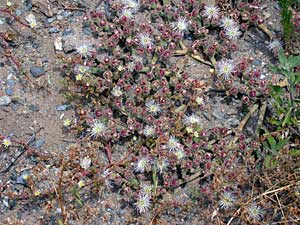
Mesembryanthemum crystallinum typical habit (Photo: Monroe,
2003). |

Mesembryanthemum nodiflorum habit
(Photo: J. Dodd, Mesembryanthemum nodiflorum.) |
Life form
Mesembryanthemum crystallinum is a robust succulent herb or dense
prostrate shrub to 1 m wide (Venning, 1984; Jacobs and Highet, 1990).
Plants are densely papillose with large bladder cells, especially prominent
on the receptacle (Hartmann, 2002). These give the plant a glistening
appearance, and hence the species name "ice-plant" (Bohnert
Laboratories, 2003). Mesembryanthemum crystallinum can be annual,
biennial or perennial (Western Australian Herbarium, 1998-), but its life
cycle is usually completed within several months, depending on environmental
conditions (Bohnert and Cushman, 2000).
Mesembryanthemum nodiflorum is morphologically similar to M.
crystallinum, although it tends to be smaller in all its parts. It
also posseses the distinctive, conspicuous bladder cells found in the
latter species (Venning 1984; Jacobs and Highet, 1990; Hartmann, 2002).
Distribution and habitats are similar for both species (see below). See
Venning (1984) for further descriptive information.
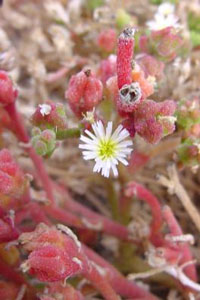
Mesembryanthemum nodiflorum
(Charters, 2003-2004a) |
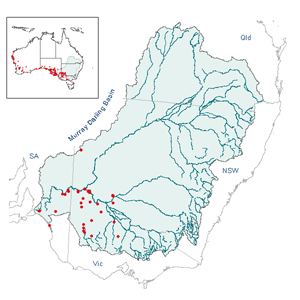
click to enlarge map
|
Distribution
Mesembryanthemum crystallinum is native to Europe and Africa.
It is introduced in Australia and is now widely distributed throughout
the southern area of the continent, extending as far north as Exmouth
on the Western Australian coast (Venning, 1984; Australia’s Virtual
Herbarium, 2004). Mesembryanthemum nodiflorum is native to southern
Africa. It is introduced in Australia and occurs widely throughout the
southern inland areas of the continent (Venning, 1984; Australia’s
Virtual Herbarium, 2004)
Habitat
Mesembryanthemum crystallinum is found on wide range of soil types,
from well-drained sandy soils (including sand dunes), to loams and clays.
It prefers acid, neutral or alkaline soils, but can tolerate nutritionally
poor or saline soils (Plants For A Future - Species Database, 1997-2003;
Australian National Herbarium, Canberra, 2004). It occurs in a range of
vegetation communities, including saltmarsh, samphire flats eucalypt woodlands
and shrublands (Cunningham et al., 1981; Venning 1984), and as
with many introduced species, also grows in disturbed sites such as roadsides,
rubbish dumps and homestead yards (Cunningham et al., 1981; Australian
National Herbarium, Canberra, 2004). It tends not to grow in shade (Plants
For A Future - Species Database, 1997-2003). Similar habitat preferences
are exhibited by M. nodiflorum.
"Status" in community
Abundance of M. crystallinum and M. nodiflorum appears
to be tied to climatic factors, with both species most common in years
of relatively high winter-spring rainfall. Both species occur as scattered
patches in a community (Cunningham et al., 1981), occasionally
forming more extensive swards in favourable habitats (e.g. saline sites).
Associated species
No species are recorded as particular associates for M. crystallinum
and M. nodiflorum, due to their wide tolerance and occurrence in
a variety of vegetation communities. Associates species recorded on specimen
labels in the Australian National Herbarium include chenopods (including
samphires), Muehlenbeckia sp., Acacia spp., Zygophyllum
spp. and Eucalyptus largiflorens (woodland) and E.
camaldulensis (forest).
Qualitative and quantitative data – abundance, cover, biomass
No specific data is available relating to cover, abundance or biomass.
Mesembryanthemum species can form dense ground cover mats
locally reaching high proportions of cover in restricted areas.
Species – interactions with other biodiversity
Mesembryanthemum crystallinum and M. nodiflorum are salt
accumulators. After plant death, the salt leaches from the decaying plant
into the surrounding soil. This increased salinity stops other, less salt-tolerant
species from establishing (see Physiological traits for more details).
Physiological traits and adaptations
Mesembryanthemum crystallinum has a developmentally programmed
switch from C3 photosynthesis to Crassulacean Acid Metabolism
(CAM) which is accelerated by salinity and drought (Adams et al.,
1998). The cold- and moderately salt-tolerant seedlings and juveniles
display relatively high rates of vegetative growth by engaging in C3
photosynthesis as long as soil moisture remains sufficient (Bloom and
Troughton, 1979; Winter et al., 1978 both in Bohnert and Cushman,
2000). With the onset of progressive drought, the plant switches to CAM,
which minimises water loss and ensures reproductive success in the absence
of rain and in saline soils (Winter, 1985 in Bohnert and Cushman, 2000).
CAM prolongs the period of net carbon gain, resulting in enhanced seed
production (Winter and Ziegler, 1992 in Bohnert and Cushman, 2000). The
plant dies from the root, progressively transferring resources towards
the seed capsule (Adams et al., 1998).
Mesembryanthemum crystallinum accumulates salt throughout its
life, in a gradient from the roots to the shoots, with the highest concentration
stored in epidermal bladder cells (Adams et al., 1998). The salt
is released by leaching once the plant dies. This results in a detrimental
osmotic environment preventing the growth of other, non-tolerant species
(Vivrette and Muller, 1977) while allowing M. crystallinum
seeds to germinate (Bohnert and Cushman, 2000).
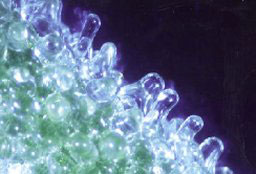
Close-up of epidermal bladder cells along the stems of Mesembryanthemum
crystallinum (Photo: Bohnert Laboratories, 2002) |
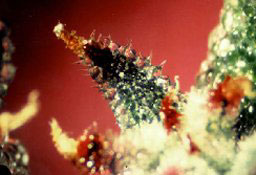
Mesembryanthemum crystallinum leaf tip. Epidermal bladder cells
are modified trichomes.
(Photo: Bohnert Laboratories, 2002) |
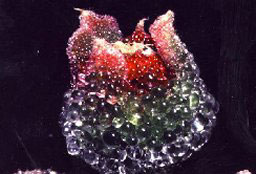
Mesembryanthemum crystallinum epidermal bladder cells in seed
capsules may be one to two mm in diameter.
(Photo: Bohnert Laboratories, 2002) |
Root growth is retarded under salinity indicating that water uptake by
the root system is not essential for plant survival at the late developmental
stages under heavy salinity (Kholodova et al., 2002).
Mesembryanthemum nodiflorum also displays the shift from C3 to
CAM present in M. crystallinum (Sayed and Hegazy, 1994). Mesembryanthemum
nodiflorum is also a salt accumulator and adds salt to the soil after
death (Dale, 1986 cited in Ruff, 1999).
Reproduction and Establishment
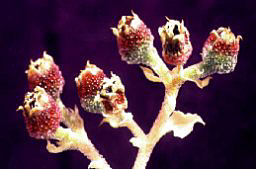
Mesembryanthemum crystallinum branch with seed capsules.
(Photo: Bohnert Laboratories, 2002)
|
Reproduction
Mesembryanthemum crystallinum and M. nodiflorum flower
in spring to early summer (Cunningham et al., 1981). Flowers open
in the morning and close at night (Smith, 1998), and are insect pollinated
(Western Australian Herbarium, 1998-).
In Mesembryanthemum crystallinum, the magnitude of seedset depends
on CAM and the size the plant has attained in its juvenile growth phase
(Adams et al., 1992 in Adams et al., 1998). During seed
production, older portions of the plant progressively senesce, die off
and dry out. The developing seed capsules continue to sequester salt and
produce viable seeds (Adams et al., 1998). Seeds at the top of
the capsule germinate immediately on imbibation while seeds at the base
remain dormant for long periods (in excess of four weeks) (Fukuhara et
al., 1999 cited in Bohnert and Cushman, 2000).
Dispersability; establishment and growth
In M. crystallinum and M. nodiflorum, seeds germinate during
the cooler months of the year and the plants grow though to mid- or late-summer
after which they dry out and die. Some plants may survive another year
if conditions are favourable (Cunningham et al., 1981). In lab
experiments five distinct growth phases have been identified for M.
crystallinum: germination, juvenile, adult, flowering and seedset.
It is in the adult phase that the plants change from C3 to
CAM (Adams et al., 1998).
Juvenile period
Under lab conditions the juvenile phase of M. crystallinum lasts
for approximately six weeks. Adult growth can be prolonged for many months.
The onset of flowering is accelerated by environmental stress, most rapidly
by salt stress. Seedset occurs about six weeks later and is accompanied
by decay of the roots, shoots and leaves (Adams et al., 1998).
Similar patterns could be expected for M. nodiflorum.
Hydrology and salinity
Salinity tolerance
Both M. crystallinum and M. nodiflorum often grow in saline
situations (Cunningham et al., 1981). Optimal growth for M.
crystallinum is obtained at moderate salinity (0.1-0.2 M NaCl). Up
to 0.5 M NaCl is tolerated well and accelerates reproductive development
(Kuznetsov et al., 2000 in Bohnert and Cushman, 2000).
Response to disturbance (non-hydrological)
Grazing
Mesembryanthemum crystallinum and M. nodiflorum are rarely,
if ever, utilised by domestic stock (Cunningham et al., 1981).
Other
Both M. crystallinum and M. nodiflorum occur in disturbed
sites, and physical disturbance of the soil may well favour establishment
and growth of both species (B.J. Lepschi, pers. obs.)
Conservation status
Mesembryanthemum crystallinum and M. nodiflorum are introduced
to Australia.
Uses (including ethnobotanical)
The leaves of M. crystallinum are edible. Seeds can also be eaten.
The crushed leaves can be used as a soap substitute and has some medicinal
uses (Plants For A Future - Species Database, 1997-2003). Mesembryanthemum
crystallinum is also used as a model in plant physiologic research
(Bohnert and Cushman, 2000), and is grown as a garden ornamental (Jessop,
1986). Due to its salt accumulation, M. crystallinum may be useful
for bio-remediation (Bohnert Laboratories, 2003).
Summary
The ability of Mesembryanthemum crystallinum and M. nodiflorum
to switch from C3 photosynthesis to CAM enables plants
to adapt to high saline and arid situations and to withstand stressful
conditions. The ability to accumulate salt, which is leached to the soil
on death, and to suppress growth of other species, provides us with experimental
potential and ability to test movement of salt in riparian areas.
Changes in water table levels and differing environmental flow regimes
with consequent effects on salinity levels may affect the distribution
of these Mesembryanthemum species, and other native species associated
with them.
References
Australia’s Virtual Herbarium. (2003) Mesembryanthemum crystallinum,
M. nodiflorum. Director of National Parks and Wildlife, Australian
Government, Commonwealth of Australia, Department of the Environment and Water Resources, Australian National Botanic Gardens, Commonwealth Scientific
and Industrial Research Organization and others. Available at:
http://www.cpbr.gov.au/cgi-bin/avh.cgi [Accessed: June 2004].
Adams, P., Nelson, D.E., Yamada, S., Chmara, W., Jensen, R.G., Bohnert,
H.J. and Griffiths, H. (1998) Growth and development of Mesembryanthemum
crystallinum (Aizoaceae). New Phytologist 138, 171-190.
Bohnert, H.J. and Cushman, J.C. (2000) The Ice Plant Cometh: Lessons
in Abiotic Stress Tolerance. Journal of Plant Growth Regulation
19, 334-346.
Bohnert Laboratories. (2002) Stages of Development in Mesembryanthemum
crystallinum. Available at: http://www.life.uiuc.edu/bohnert/mesem/
[Accessed: June 2004].
Bohnert Laboratories. (2003) Mesembryanthemum. Available at: http://www.life.uiuc.edu/bohnert/projects/mesem.html
[Accessed : June 2004].
Charters, M.L. (2003-2004a) Available at: http://www.calflora.net/bloomingplants/slenderleavediceplant.html
[Accessed: June 2004].
Charters, M.L. (2003-2004b) Mesembryanthemum crystallinum. Available
at: http://www.calflora.net/bloomingplants/crystallineiceplant.html [Accessed:
June 2004].
Cunningham, G.M., Mulham, W.E., Milthorpe, P.E. and Leigh, J.H. (1981)
Plants of Western New South Wales. Soil Conservation Service of New South
Wales.
Dodd, J. Mesembryanthemum nodiflorum. Western Australian Herbarium,
Department of Conservation and Land Management. Available at: http://florabase.calm.wa.gov.au/browse/photo?f=110&level=s&id=2814
[Accessed: June 2004].
Hartmann, H.E.K.(ed) (2002) Illustrated handbook of succulent plants.
Aizoaceae, F-Z. Springer, Berlin.
Jacobs, S.W.L. and Highet, J. (1990) Aizoaceae. In Harden, G.J.
(ed) Flora of New South Wales Volume 1. pp 188-199. New South Wales University
Press, Australia.
Jessop, J.P. (1986) Family – Aizoaceae (Ficoidaceae, Mesembryanthemaceae,
Molluginaceae, Tetragoniaceae). In Jessop, J.P. and Toelken, H.R.
(eds) Flora of South Australia Part I, Lycopodiaceae – Rosaceae.
South Australian Government Publishing Division, Adelaide.
Kholodova, V.P., Neto, D.S., Meshcheryakov, A.B., Borisova, N.N., Aleksandrova,
S.N. and Kuznetsov, Vl.V. (2002) Can stress-induced CAM provide for performing
the developmental program in Mesembryanthemum crystallinum
plants under long-term salinity? Russian Journal of Plant Physiology
49, 336-343.
Monroe, G.A. (2003) 'The PLANTS Database'. National Plant
Data Center, Baton Rouge, USA. Available at: http://plants.usda.gov/cgi_bin/large_image_rpt.cgi?imageID=mecr3_001_ahp.tif
[Accessed: June 2004].
Plants For A Future - Species Database. (1997-2003) Mesembryanthemum
crystallinum. Available at: http://www.scs.leeds.ac.uk/cgi-bin/pfaf/arr_html?Mesembryanthemum+crystallinum
[Accessed: June 2004].
Ruff, R.D. (1999) Small-Flowered Ice Plant (Slender-Leaved Ice Plant).
Available at: http://mamba.bio.uci.edu/~pjbryant/biodiv/PLANTS2/Aizoaceae/Mesembryanthemum_nodiflorum.htm
[Accessed: June 2004].
Sayed, O.H. and Hegazy, A.K. (1994) Growth-specific phytomass allocation
in Mesembryanthemum nodiflorum as influenced by CAM induction in
the field. Journal of Arid Environments 27, 325-329.
Smith, G.F. (1998) Mesembs of the world. Briza Publications, Pretoria.
Venning, J. (1984) Mesembryanthemum. In George, A.S. (ed) Flora
of Australia Volume 4, Phytolaccaceae to Chenopodiaceae. pp 21-24. Australian
Government Publishing Service, Canberra.
Vivrette, N.J. and Muller, C.H. (1977) Mechanism of Invasion and Dominance
of Coastal Grassland by Mesembryanthemum crystallinum. Ecological
Monographs 47, 301-318.
Walsh, N.G. (1996) Aizoaceae. In Walsh, N.G. and Entwisle, T.J.
(eds) Flora of Victoria Volume 3, Dicotyledons, Winteraceae to Myrtaceae.
pp 105-119. Inkata Press, Melbourne.
Western Australian Herbarium. (1998-) FloraBase – The Western Australian
Flora. Department of Conservation and Land Management. http://florabase.calm.wa.gov.au/
|

